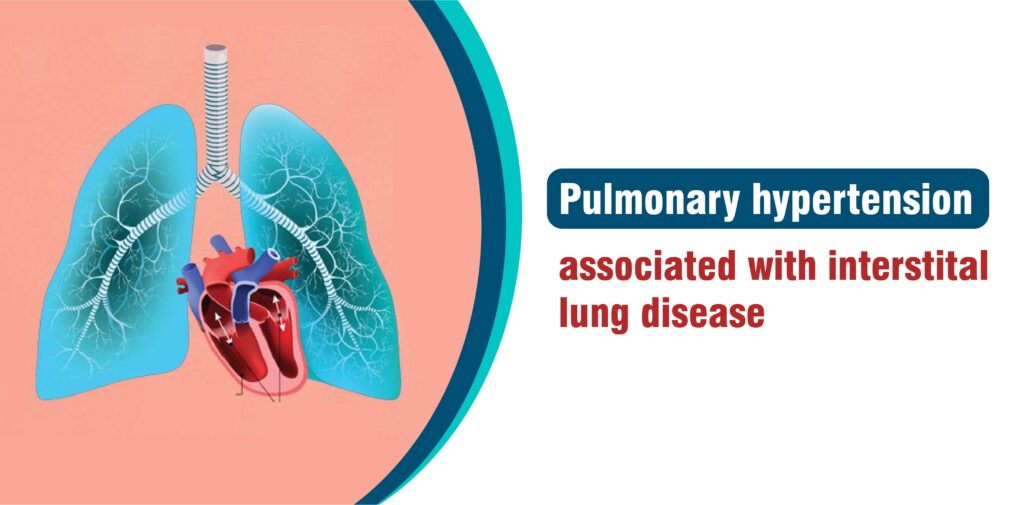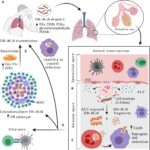Pulmonary hypertension associated with interstitial lung disease (PH-ILD) is a complex and progressive cardiopulmonary disorder in which elevated pulmonary arterial pressure occurs secondary to chronic fibrotic lung disease. This combination significantly worsens morbidity and mortality in affected individuals. Understanding the intersection of these two pathologies is critical for early detection, appropriate classification, and individualized treatment planning.

Pathophysiology of PH-ILD
Interstitial lung disease (ILD) encompasses a heterogeneous group of disorders characterized by inflammation and fibrosis of the lung interstitium. This progressive fibrosis leads to destruction of alveolar architecture, impaired gas exchange, and hypoxemia.
Chronic hypoxia is a key driver of pulmonary vascular remodeling. Over time, it causes vasoconstriction and intimal fibrosis of the pulmonary arteries, leading to increased pulmonary vascular resistance (PVR). The right ventricle must work harder to pump blood through the stiffened arteries, eventually leading to right-sided heart failure.
Classification of Pulmonary Hypertension in ILD
Pulmonary hypertension is categorized into five WHO groups. PH-ILD falls under Group 3, which includes pulmonary hypertension due to lung diseases and/or hypoxia.
While mild elevation in pulmonary artery pressure is common in advanced ILD, PH-ILD is diagnosed when mean pulmonary artery pressure (mPAP) is ≥20 mmHg, pulmonary arterial wedge pressure (PAWP) ≤15 mmHg, and PVR ≥3 Wood units on right heart catheterization.
Causes and Risk Factors
The development of PH in patients with ILD is multifactorial. Key contributing factors include:
- Chronic hypoxemia
- Extensive fibrotic remodeling of pulmonary tissue
- Endothelial dysfunction
- Imbalance of vasodilators (e.g., nitric oxide) and vasoconstrictors (e.g., endothelin-1)
- Inflammatory cytokines contributing to vascular remodeling
Patients with connective tissue diseases (especially systemic sclerosis), idiopathic pulmonary fibrosis (IPF), and combined pulmonary fibrosis and emphysema (CPFE) are at heightened risk.
Clinical Presentation of PH-ILD
PH-ILD often presents insidiously, overlapping with symptoms of underlying lung fibrosis. However, disproportionate severity or rapid worsening of symptoms may indicate the development of pulmonary hypertension.
Common Symptoms
- Exertional dyspnea unresponsive to oxygen therapy
- Fatigue and weakness
- Chest discomfort or tightness
- Exertional syncope
- Peripheral edema and signs of right heart failure
On examination, findings may include a loud P2 component of the second heart sound, right ventricular heave, jugular venous distention, and hepatomegaly.
Diagnostic Approach
Diagnosing PH in patients with ILD requires a high index of suspicion and a multimodal diagnostic workup.
1. Pulmonary Function Testing (PFT)
- Reveals restrictive patterns: reduced FVC and DLCO.
- A disproportionate reduction in DLCO (<40%) may suggest concurrent PH.
2. High-Resolution CT (HRCT) of the Chest
- Confirms the presence, extent, and pattern of interstitial lung disease.
- May show enlarged pulmonary arteries as a clue to PH.
3. Echocardiography
- Non-invasive screening tool.
- Estimates pulmonary artery systolic pressure (PASP).
- Evaluates right ventricular size and function.
4. Right Heart Catheterization (RHC)
- Gold standard for PH diagnosis.
- Confirms hemodynamic parameters: mPAP ≥20 mmHg, PAWP ≤15 mmHg, and elevated PVR.
5. Six-Minute Walk Test (6MWT)
- Assesses functional status and exercise-induced desaturation.
- Oxygen desaturation during 6MWT is predictive of poor outcomes in PH-ILD.
Management of PH-ILD
The cornerstone of PH-ILD management is optimizing ILD therapy, correcting hypoxemia, and providing supportive care. While therapies approved for pulmonary arterial hypertension (PAH) are not universally indicated, emerging treatments offer hope for selected patients.
1. Oxygen Therapy
- Maintains oxygen saturation >90%.
- Reduces hypoxic vasoconstriction and progression of pulmonary hypertension.
2. Antifibrotic Therapy
- For patients with idiopathic pulmonary fibrosis or progressive fibrosing ILDs:
- Nintedanib and pirfenidone slow disease progression.
- Their role in reducing PH burden is still under investigation.
3. Pulmonary Vasodilators
The use of pulmonary vasodilators in PH-ILD is controversial due to the risk of worsening ventilation/perfusion mismatch. However, recent evidence has reshaped this paradigm.
Inhaled Treprostinil
- FDA-approved in 2021 for PH-ILD.
- Improves exercise capacity and quality of life.
- Administered via an inhaled route, it avoids systemic vasodilation and V/Q mismatch.
4. Supportive Care
- Diuretics for right heart failure and fluid overload.
- Vaccinations to prevent respiratory infections.
- Pulmonary rehabilitation to enhance functional capacity.
5. Lung Transplantation
- Considered in eligible patients with advanced PH-ILD unresponsive to medical therapy.
- Requires careful patient selection and referral to transplant centers.
Prognosis and Outcomes
PH-ILD significantly worsens prognosis compared to ILD alone. Right ventricular failure is a major cause of morbidity and mortality. Median survival is notably reduced in patients with confirmed PH-ILD.
Early diagnosis, targeted therapy, and integrated management improve quality of life and may delay disease progression. Risk stratification based on functional status, biomarkers, and echocardiographic or hemodynamic measurements is essential for guiding therapy.
Future Directions
- Precision medicine approaches are being explored to tailor therapy.
- Ongoing clinical trials are assessing the safety and efficacy of combination antifibrotic and vasodilator therapy.
- Biomarker development may facilitate earlier diagnosis and disease monitoring.
Pulmonary hypertension associated with interstitial lung disease is a life-limiting complication that demands early recognition and a multidisciplinary treatment strategy. With advances in diagnostic modalities and novel therapies like inhaled treprostinil, clinicians are better equipped to manage this complex condition. A patient-centric, evidence-based approach is essential to improve clinical outcomes in PH-ILD.

